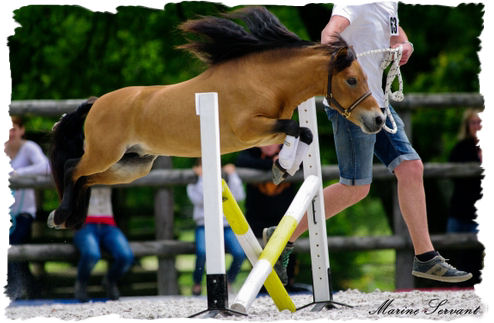
Jumping with the Miniature Horse
Jumping with a Miniature Horse is an activity where the handler is running alongside the horse. The horse jumps, while he is held by his handler, who accompanies him on the parcours without jumping the obstacles himself. This is a fun activity, but also as a sport for the horse ... and his handler. The miniature horse has a quite surprising capacity to jump: it is not uncommon to see minis jump more than their height at the withers (or last hair to stay in U.S. measurements). A jumping class is frequently proposed in competitions or shows for miniature horses.
The perfect Miniature Horse for jumping
The jumper horses may have a very different conformation from one to another, but as for any sport activity, the conformation of the horse is of great importance for its performance. Conformation is closely linked to the quality of movement and gaits. For a good jumping ability , the horse should be balanced and have ample and regular gaits. He must have good leg conformation and rather long legs. The horse should have well-developed muscles. Because propulsion is important for jumping, the horse will preferably have powerful hindquarters and strong hocks. The back is ideally done "uphill", ie with the withers higher than the croup. Good shoulder angulation allows the amplitude and liberty of movement. It is advantageous that the miniature is "a bit of size", so we choose a horse in the upper range of the standard (up to 34 inches for AMHA registred horses) . The good jumper horse is a rather large, broad and compact. Horses extremely dainty and refined often have neither the strength nor the stamina for the competitive jumping .
A good jump dispositional is an undeniable asset: the good jumper collects before the obstacle, then propels, extends and rounds above the obstacle. A horse that bounces like a deer, jumps with the inverted neck and stiff back, comes quickly to its limits.
The caracter of the jumper horse is of great importance. Willingness to perform is an important prerequisite for a successful jumper. Overall the jumper horse should enjoy his job, while beeing respectfull for his handler. Don't forget we will run beside him, so he needs to be easy to lead. The horse should not be lazy, if we have to drag him behind us, we won't obtain any good result.
How to train the Miniature Horse to jump ?
Horses in jump training must be at least 3 years old. Horse's legs are fragile and jumping is a strong stress for joints and tendons. But we can do other training before the age of 3 years, and it is also recommended- like "trail exercices" (= Halter Obstacle) going through water, steping on a plateform, walking across ground poles... and occasionnally jumping a small cavaletti. These exercises are a great preparation for future jumping training, developp the balance and obedience of the horse and increase the bonding and teamwoek between the horse and his handler. A solid basic education is required before starting the jumping training.
Before any session of training, it is imperative to relax the horse and give him the opportunity to warm up his muscles. This can be done along the lunge line or loose in a round pen. The warm-up also helps to put the horse in a work attitude, and to check his obedience.
The first step of jumping is training over ground poles in hand or along the lung line on a large circle. The advantage of doing these exercises at the lunge line is that we do not disturb the horse with our own tempo: The horse can find and keep his own cadence and focus on to raise his feet above the poles. He also learns to manage the length of his steps. And for us it is easier to judge the movement from a distance rather than up close right next to the horse.
 |
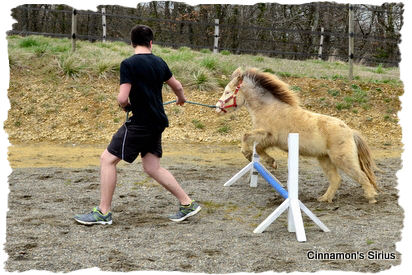 |
When the horse is comfortable on crossing ground poles, while he keeps his balance and maintain a steady, even cadence you can vary the exercises by raising the height of the last pole, or by presenting an obstacle of symbolic height (10-15 cm ). Height is not the priority, it will come later, the essential point is that the horse learns to manage his speed and balance when coming close to the obstacle and between the obstacles. There are no absolute rules, you must adapt to the horse and especially it has to remain fun for him. I recommend short workouts of 15-20 minutes including warm up, and I am always generous with praise and treats. I always stop across something positive, never on a "defeat", even left to shorten a lesson if the horse has been particularyly successful. I do trainings for the same discipline at most 2-3x per week.
It is only when the horse controls balance and cadence over small obstacles, that I will gradually increase the height, width and difficulty with combinations of obstacles and finally a small course.
 |
 |
A video of a jumping training :
Obstacles adapted to the Miniature Horse
The Miniature Horse is of course a lot thinner and lighter than a large horse. It is therefore not recommended to use "classic" obstacles and poles available for large horses, at least when height of jumping is increased jump and therefore the risk that the horse hangs a bar. The pole must be designed to fall if the legs of the horse face too much. The horse should not be injured or come to fall, it is the obstacle that must drop!
You can find obstacle material adapted to Miniature Horse at Mini Horse Shop (NL) , or if it is possible to do it yourself, such as the model below:
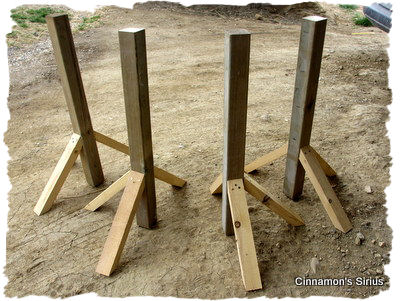 |
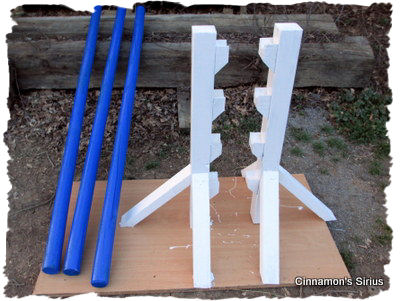 |
 |
 |
 |
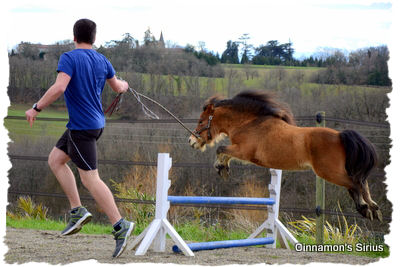 |
The equipment of the Miniature Horse for jumping
It does not really need a lot of harness for a Minaiture Horse to jump: a suitable and comfortable halter or cavesson is enough to lead the horse. A lead rope of medium lenght, such as the "horsemaship leadrope", is practical and can leave a little more liberty to the horse than a normal leadrope, which can be very useful when the handler and the horse are not completely synchronized in speed and movement.
It is advisable to protect the horse's legs, especially the front legs -with boots or wraps. Appropriate equipment is available in various saddleries specialized for Miniature Horse tack (see our page -> links)
The pleasure of jumping ... some pictures of competition (Icon at Saillenard 2013)
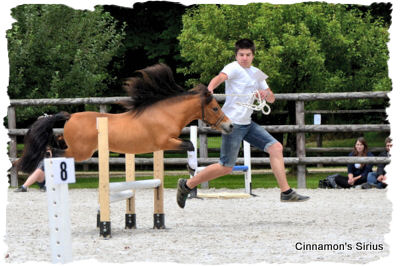 |
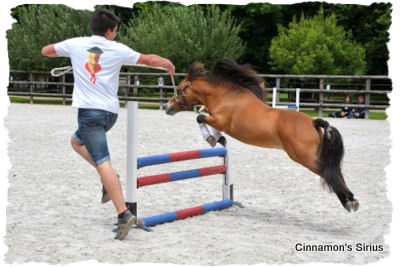 |
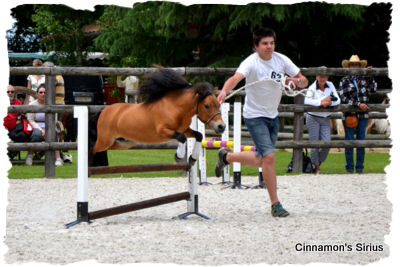 |
 |
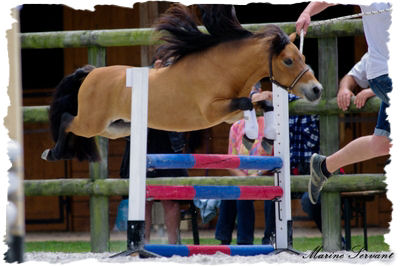 |
 |

